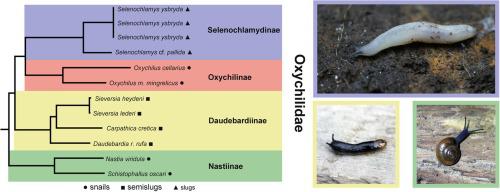Molecular Phylogenetics and Evolution ( IF 3.6 ) Pub Date : 2020-06-23 , DOI: 10.1016/j.ympev.2020.106897 Marco T Neiber 1 , Frank Walther 1 , Bernhard Hausdorf 1

|
We analysed the phylogenetic relationships of the enigmatic ghost slug Selenochlamys with other Western Palaearctic Limacoidei based on mitochondrial and nuclear sequences. Selenochlamys is a carnivorous slug group from the Caucasus region. Until now, it has been classified in Trigonochlamydidae, which includes several carnivorous slug groups from the Caucasus region. However, the molecular phylogenetic analyses revealed that Selenochlamys originated from omnivorous snails belonging to Oxychilidae. The similarities of Selenochlamys and Trigonochlamydidae are convergences resulting from limacization, the evolutionary transition from shelled snails to slugs, and from the transition from herbivory or detritivory via omnivory to obligate carnivory. These two evolutionary trends occurred repeatedly within the Limacoidei. Phylogenetic analyses based on morphological characters are prone to underestimate the instances with which such recurrent evolutionary trends occurred, as they depend on the parsimony criterion. The molecular phylogenetic analyses revealed that Limacoidea and Parmacelloidea, which were at least partly based on characters associated with limacization, are polyphyletic. The molecular phylogenetic tree implied that 5–7 independent limacizations occurred in the Western Palaearctic Limacoidei. Half of these limacizations remained undetected in a previous parsimony analysis based on morphological characters. Moreover, the analyses revealed that Godwiniinae belong to Gastrodontidae, not Oxychilidae.
中文翻译:

幽灵(Selenochlamys)与被忽视的西古古太平洋Limacoidei(Gastropoda:Stylommatophora)的实例化的亲缘关系。
我们基于线粒体和核序列分析了神秘的幽灵子弹Selenochlamys与其他西方古古猿Lmacoidei的系统发育关系。Selenochlamys是高加索地区的肉食性类。到目前为止,它已被归类为三角龙科,其中包括来自高加索地区的几个食肉。然而,分子系统发育分析表明,硒len科起源于草Ox科杂食性蜗牛。Selenochlamys的相似之处Trigonochlamydidae和Trigonochlamydidae是由软化,从带壳的蜗牛到的进化过渡以及从食草或有害物通过杂食性到专性食肉动物的过渡而产生的趋同。这两种进化趋势在Limacoidei中反复发生。基于形态学特征的系统进化分析容易低估发生此类反复进化趋势的情况,因为它们依赖于简约性标准。分子系统发育分析表明,至少部分基于与软化相关的特征的软毛纲和软毛纲是多亲的。分子系统树表明,在西古北洋大猿科中发生了5–7个独立的大猿科。在以前的基于形态学特征的简约分析中,这些Limacization的一半仍未被发现。此外,分析表明,戈德温亚科属于天蛾科,而不是叶甲科。











































 京公网安备 11010802027423号
京公网安备 11010802027423号